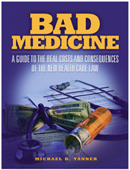
Commentary: New Insights on Obamacare from Cato Institute
Revised ‘Bad Medicine’ determines health care reform a costly failure
Michael Tanner, a senior fellow at the Cato Institute, has released a revised version of his July 2010 report, “Bad Medicine: A Guide to the Real Costs and Consequences of the New Health Care Law.”
His newer findings affirm that the Patient Protection and Affordable Care Act has been and will be a tremendous failure compared with its stated objectives. With newer, more accurate cost calculations and legal cases from the first year of implementation, Tanner dispels the notion that PPACA is achieving health care for all Americans, reduced cost of insurance, and increased quality of care.
Tanner’s extensive report presents damning statistical evidence. By 2019, for example, roughly 21 million Americans will be uninsured, and the PPACA will cost even more than initially advertised. He estimates that the first 10 years will require $2.7 trillion and add more than $823 billion to the national debt. Despite Obama administration claims otherwise, the new law will increase taxes by over $569 billion by 2019, hamper economic growth, and reduce employment.
Moreover, most workers and businesses will not see their insurance costs reduced, and the youngest and healthiest members of our society will see their premiums rise dramatically. Millions of Americans will lose their current insurance, even if they are satisfied with it. Tanner refers to a “conservative” estimate by the CBO that 10-12 million workers will be dropped from their current employer-based coverage.
He also contends that the PPACA lays the foundation for government rationing of health care and interference in medical practice.
On these grounds, Tanner rightfully labels the new health care law a “colossal failure” which will irrevocably transform American health care, and by extension American society, for the worse.
“It has rewritten the relationship between the government and the people, moving this country closer to European-style social democracy,” Tanner argues.
PPACA’s proponents intend it to address the fact that Americans spend more on health care than any other country and that health care costs are rising faster than GDP growth. This spending, an annual $2.5 trillion, is more than Americans spend on housing, food, defense, or automobiles.
However, the PPACA has failed to relieve this strains, and is only raising the cost and reducing the quality of care and access.
While Tanner’s report on PPACA is compelling – and alarming – he offers little reassurance of PPACA’s repeal. Our best hopes for eliminating it rest in the courts and in Congress, as well as in the individual efforts of the states, as arduous as that road might be. Even if an outright repeal is unlikely, we ought to demand that conservative legislators put forth every effort to defund and disarm the law. As Tanner ably demonstrates, the effects of this health care law will be ruinous if fully implemented.




